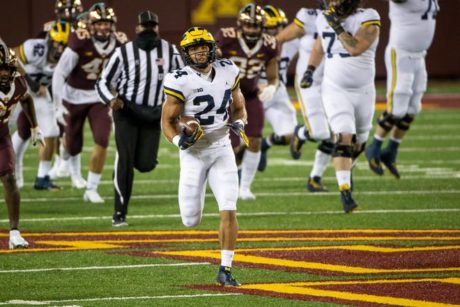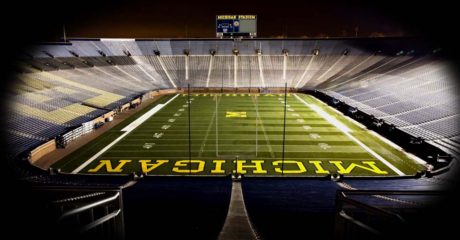
The other day I posted about Michigan’s running back rotations (LINK). Today I will be addressing why running backs might get rotated.
Use the Amazon links here to support TTB (LINK):
There are a lot of reasons to rotate running backs from play to play. Ideally, you have a perfect, three-down running back who never gets hurt or makes mental mistakes . . . but those are rare.
Hit the jump for a discussion of eight reasons to sub in new running backs.
1. Fatigue: This one is pretty self-explanatory, but fatigue can set in for even the best trained athletes. Sometimes a guy needs a breather and some water, especially if he’s being fed the ball over and over again. Or if he just broke off a 60-yard run.
2. Injury: Injury.
3. Discipline: I included this one not because it’s a common issue, but there is a chance that any player might need to be reined in for unsportsmanlike behavior.
4. Coaching tips: This is rare that a running back would need to be removed from the game in the middle of a drive for a coaching tip, but occasionally, defenses do something to confuse a back in pass protection or on his run keys. But if you run an offense predicated on inside zone, for example, and a defense does a particular thing (charging the mesh, for example), the running backs coach might want to pull him out for a play or two to talk to or remind him of some things. Maybe the running back messed up on play #2 on the drive, and there’s a good chance that inside zone will be run again two or three more times on that same drive and it needs to be addressed immediately.
5. Pass protection: This is a big one, and we have seen it play out many times for Michigan over the years. A few players who were excellent pass protectors: Mike Hart, Vincent Smith, De’Veon Smith, Zach Charbonnet. A few players who struggled in pass protection: Carlos Brown, Derrick Green, Ty Isaac. Michigan’s coaches have made a lot of adjustments over the years, such as Brady Hoke bringing in Vincent Smith on third downs to help protect the quarterback.
6. Pass receiving skills: Speaking of Vincent Smith, it also helped that he was great at running and catching screens. Pass receiving backs need to have reliable hands, and they also need sufficient quickness to beat linebackers on routes and make somebody miss. A good receiving back often catches the ball in the flat, where he has to make at least one guy miss to gain any yardage.
7. Trickery and subterfuge: One reason to use a particular back for a play is his ability to throw the ball, hand off the ball, etc. Michigan does not typically run a lot of trick plays, but guys like Vincent Smith and Hassan Haskins have attempted passes in the past. Some guys also just have a better feel for pitching the ball (on a reverse or flea flicker) or handing off the ball (on a reverse or double reverse). Also, on 4th-and-2, you may want to use your best short yardage back to sell a hard fake on a play action pass.
Scenario: Karan Higdon goes for 9 yards on a 3rd-and-11 draw, setting up for De’Veon Smith to enter on 4th-and-2 for a play action pass.
8. Run scheme efficiency: I saved this for last, because I think it requires the most nuance when it comes to coaching and the analysis of substitutions. Different running backs are better at running certain schemes than others. Some examples from Michigan history:
- Power: Anthony Thomas. Thomas had a good combination of patience, burst, and size/strength to run this play.
- Counter: Anthony Thomas, Tim Biakabutuka. I couldn’t choose between these two as being the best example, because I loved how they both set up counter. They got good depth and timed it up pretty perfectly, while also displaying that aforementioned patience, burst, and power.
- Inside zone: Hassan Haskins. Haskins has the patience, vision, and toughness to run inside zone, and he also makes some really good cuts for being a bigger back (6’1″, 220 lbs.).
- Outside zone: Mike Hart. Hart displayed perhaps the best vision of any Michigan running back. His lack of speed could be frustrating at times, but he made so many people miss, found so many cutback lanes, and broke so many tackles that he could be very efficient.
- Toss sweep: Ty Isaac. In recent memory, Isaac has been the best at running the toss. He seemed most comfortable at running outside the tackles, and had the vision/patience in space to make things happen with linemen pulling in front of him.
- Pin and pull: Karan Higdon. Higdon was a slasher with pretty good speed. He made pretty good reads and, like the guys who ran power/counter well, he showed the patience and burst to gain chunks of yards.
- Down G: Tim Biakabutuka. Biakabutuka was a soccer player growing up, and he wasn’t the best at running between the tackles. Where he excelled was running off tackle, because while he had some power, he also had the quickness to bounce it all the way outside if necessary.
- Iso: Tyrone Wheatley. I probably could have chosen Wheatley for a few of these categories, but he played almost 30 years ago, so memories might be vague. Listed at 6’1″ and 225 lbs., he was probably the most physically talented back in Michigan history, taking into account his sprinter’s speed.
- Power read: Fitzgerald Toussaint. Toussaint was a short-ish back (5’10”) whose combination of toughness and speed made him a threat getting to the edge. You want someone who can both threaten to make a big play down the sideline and also run through tackle attempts of players he might find out there (outside linebackers, safeties, and corners).
Of course, there are all kinds of run concepts I didn’t include here (wham, trap, etc.), but those are some of the most commonly used ones from the last 30 years.
I understand those runners are cherry-picked from the last three decades of Michigan football, so let me apply reason #8 to Michigan’s 2020 roster:
Zach Charbonnet: Charbonnet is mostly an inside runner as a bigger back with some power. He had a 70-yard touchdown on power against Minnesota and has had some big plays on inside zone. I also think he has the quickness to be used on power read, pin and pull, etc., things that go off tackle, but that’s not how Michigan used him. Charbonnet is also Michigan’s best pass protector.
Blake Corum: Corum is the smallest and quickest back on the team, which ideally puts him on the list for outside zone, toss sweeps, power read, etc. While he has admirable toughness and vision to run inside, it’s just tough to do at that size. He also has the quickness to be an asset in the passing game, on wheel routes, etc.
Chris Evans: Evans has good hands and was recruited by some to be a receiver in college. You can create mismatches with him by splitting him out wide or into the slot. He has pretty good quickness, so he likes to bounce things outside whenever possible. But if there’s a large enough hole inside, he can hit it with drive through some tackles.
Hassan Haskins: Haskins is the best inside zone runner on the team, and he can also run pin and pull, one back power, power, etc. He lacks the speed to do much outside the tackles, so you want him to run plays where he can keep – or at least get – his shoulders square to the line of scrimmage.
Christian Turner: Turner never really got enough playing time for me to identify where he excelled. My operating theory is that he has the least upside of any of Michigan’s backs and does not necessarily excel in any aspect, though he did have a nice run against Florida a couple years ago.
TAKEAWAYS
With Michigan having an offense that employs multiple schemes – power, inside zone, pin and pull, etc. – the need for a variety of running skills is apparent. I think the most complete back is Charbonnet, but obviously Michigan’s staff has not used him with a great deal of regularity.
Some teams really only focus on one or two schemes, such as the North Carolina Tarheels. It’s probably not a coincidence that they had two backs run for 1,100+ yards, and they combined for 28 rushing touchdowns in 2020.
There was some talk that Michigan was putting too much on its players when Jim Harbaugh first arrived, and perhaps that is still the case with Josh Gattis as the offensive coordinator. Not every offense has to be as simple as North Carolina’s, and Michigan was bound to struggle in 2020 with all the injuries and NFL departures on the offensive line. But perhaps Michigan would benefit from cutting down on the playbook, which would also cut down on the number of backs who would get reps.
The last part in the series will cover how substitutions work in game preparation and on game day.
You need to login in order to vote


You must belogged in to post a comment.